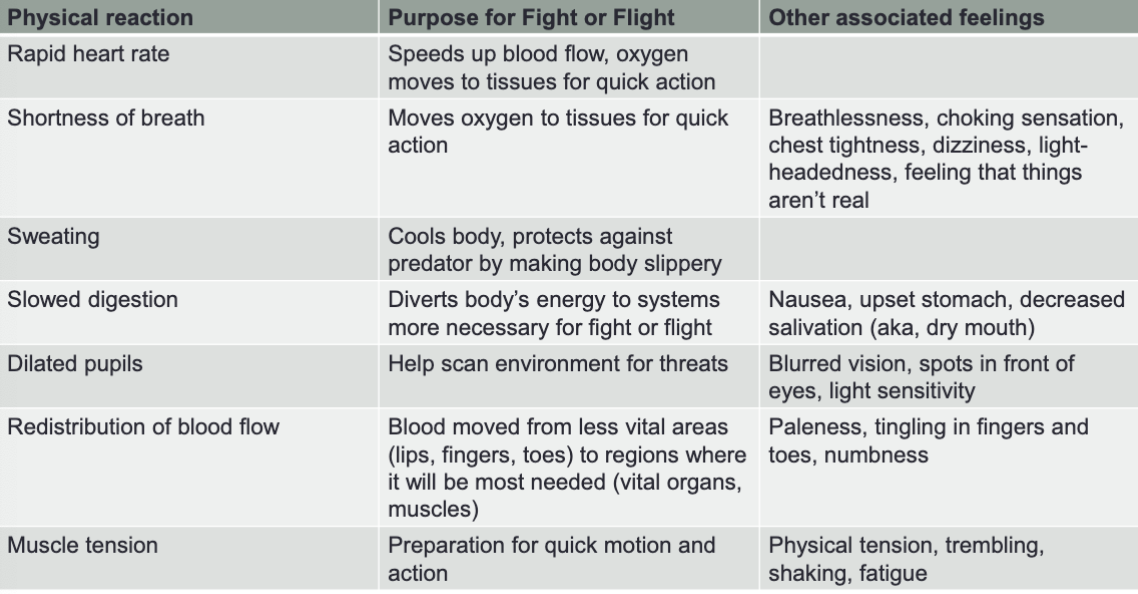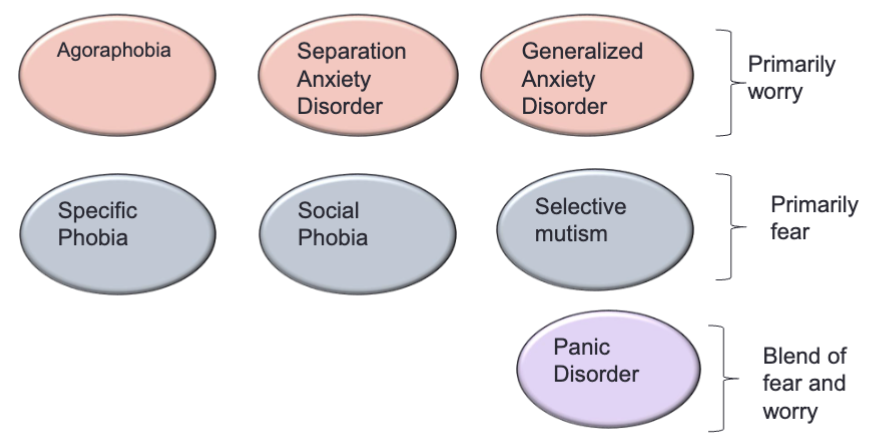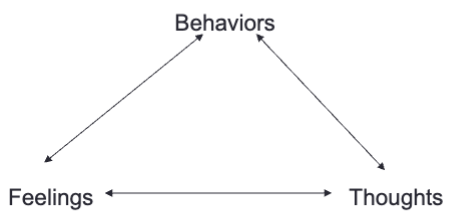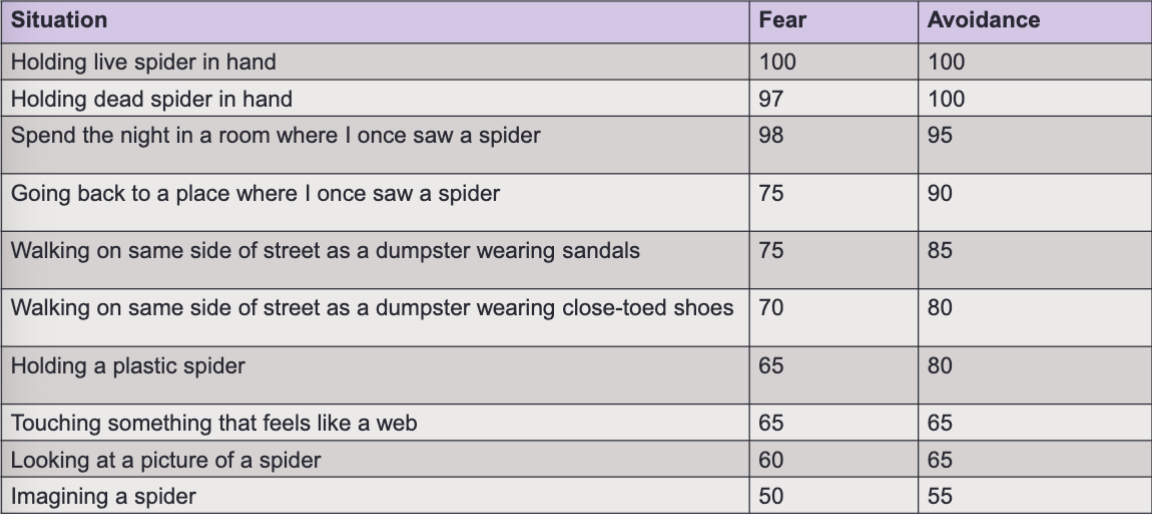10/16/25-10/21/25 Anxiety disorders
1/32
There's no tags or description
Looks like no tags are added yet.
Name | Mastery | Learn | Test | Matching | Spaced |
|---|
No study sessions yet.
33 Terms
What is anxiety?
Emotional state marked by the anticipation of danger of misfortune, intense distress, bodily tension, and nervousness
Accompanied by physical sensations
Why are people anxious?
It is a functional response- lack of anxiety is problematic, since it emerges in response to perceived threat
Throughout human history, anxiety played a pivotal role in the survival of our species
Creates physical change (aka fight or flight response) that mobilizes us to guard against or escape from danger successfully
What is the effect of anxiety being part of our evolutionary heritage?
We will all always experience it
What do anxiety disorders entail?
Levels of anxiety that are frequent, debilitating, and disproportionate to the circumstances
General prevalence of anxiety disorders
Among the most prevalent psychological disorders, ~1/3 of people will experience an anxiety disorder at some point
When does an anxiety disorder commonly start?
In childhood
What is one explanation for the high prevalence of anxiety disorders?
Humans who are alive today are the ones whose ancestors developed the keenest reactions to threats
How does evolution explain the early onset of anxiety?
Even a very young child needs to be prepared for fight or flight
What are physical signs of anxiety derived from?
Derived from fight-or-flight response, it prioritizes directing energy to the most essential functions for survival
Does anxiety bring on the same or different symptoms depending on the circumstances?
The same symptoms manifest in you, regardless of the circumstances that bring them on, reflecting how fight-or-flight is effective against many types of threat
Examples of physical reactions / purpose for fight or flight / other associated feelings

2 main cognitive symptoms of anxiety
Perception of threat or danger- when we are anxious, we perceive ourselves as in danger even though we are physically safe
Worry- repetitive negative thoughts about the possibility of future danger, misfortune, or hardship
Are worry and perception of threat short-term or long-term?
Both worry and the perception of threat are often illusory
How are fear and worry different?
Fear and worry are related, but fear tends to be present-oriented (right now) whereas worry tends to be future oriented (anticipation)
“I’ve had a lot of worries in my life — most of which have never happened.” -Mark Twain
7 anxiety disorders in the DSM-5

Comorbidity and anxiety disorders
Anxiety disorders are highly comorbid with each other.
People may often have predisposition towards anxiety, but will have different anxiety disorders at different points in their lives
Specific Phobia criteria
Marked fear or anxiety about a specific object or situation (e.g. flying, heights, animals, needles, blood, etc.)
Phobic object or situation almost always provokes immediate fear or anxiety. It is actively avoided or endured with intense fear or anxiety.
The fear or anxiety is out of proportion to the actual danger posed by the specific object or situation and to the sociocultural context.
The fear, anxiety, or avoidance is persistent, typically lasting 6+ months.
The fear, anxiety, or avoidance causes clinically significant distress or impairment in social, occupational or other important areas of functioning
Failure to meet the functioning criteria is why most of our normal fears are not considered phobias
Specific Phobia: main phobia categories
Blood, injection, injury
Situations (e.g. enclosed spaces, airplanes, elevators, bridges)
Natural environment (e.g. storms, heights)
Animals
In terms of evolutionary psychology, what is a theory about the main phobia categories?
These stimuli are things that posed a consistent threat to human survival throughout history, such as poisonous animals, dangerous environmental situations, and events that could cause injury or infection, like bleeding
Specific Phobia: if a phobic stimulus is encountered, what will happen?
The person will experience immediate fear/horror
What is the main behavioral symptom of anxiety?
Avoidance, because people do not want to feel that level of fear/distress
How is avoidance a paradox?
It reduces anxiety short-term, but will increase anxiety long-term, because it solidifies beliefs around phobic stimulus.
It also limits the opportunity to learn that seemingly threatening circumstances are not dangerous, so there is no formation of new beliefs or experiences.
Avoidant behavior provides negative reinforcement
Each time you engage in avoidant behavior, you eliminate aversive feelings of anxiety, making it more likely that you will engage in that behavior again/repeat it in the future
Treating phobias
The core of treatment is to eliminate reinforcement associated with avoidance.
If we consciously modify an avoidant behavior, we can change the beliefs that maintain anxiety and anxious feelings themselves

How can we eliminate the reinforcement associated with avoidance?
Through exposure therapy
Exposures (aka CBT for Specific Phobia)
The most effective treatments for phobias all involve exposure to a fear-provoking stimulus, but limiting the anxiety-reducing response (avoidance)
With prolonged exposure, people habituate (body acclimates to the feeling of anxiety), affirming that they can deal with a situation like this
Exposures help people form new beliefs about the feared situation and their ability to cope with it
What happens when confronting the phobic stimulus without avoidance?
Anxiety will be experienced → through this, exposure therapy is essentially making people more anxious right now, so that they will become less anxious in general
Fear and Avoidance Hierarchy
Part of exposure therapy
Developed collaboratively with therapist
Ordered list of situations in which a client experiences fear of phobic stimulus
Used as a guide for exposures in therapy, clients will work from least feared to most feared stimulus
Each situation gets rated in terms of how much fear it generates and the lengths to which a client will go to avoid that situation

How are Fear and Avoidance Hierarchies individualized?
Every hierarchy is individualized to the client’s specific fears
Steps for effective exposure
Identify thoughts about situation before exposure occurs
Rate level of distress before exposure begins
During exposure, continue to rate distress every 5 minutes
During exposure, stay focused, do not try to distract self (avoidant behavior)
During exposure, maintain objective awareness of physical symptoms and thoughts
Continue exposure until anxiety goes down, 3 or 4 on a scale of 10 is optimal aka manageable feelings
After exposure, rate level of distress and evaluate thoughts again
Most important rule of anxiety treatment in general
Never stop an exposure before habituation occurs.
Otherwise, all that is reinforced is the sense that the anxiety producing stimulus is something that should be feared.
What are the 3 ways that exposures be conducted?
In session
In vivo (in life) - return to the place where the stimulus occurred
Imaginal
Goal for anxiety treatment
Realization that even though anxiety is uncomfortable, the risks of anxiety are minimal.
The goal is not to “get rid of anxiety”